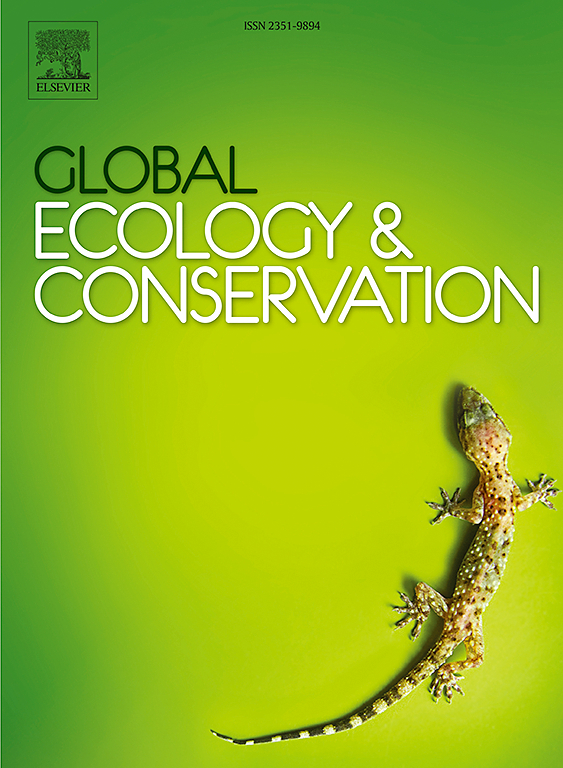城市避难所增强了一种受到入侵掠食者迅速蔓延威胁的濒危地方性拱心石蜥蜴的持久性
IF 3.4
2区 环境科学与生态学
Q1 BIODIVERSITY CONSERVATION
引用次数: 0
摘要
城市化塑造了全球生物多样性的格局。城市地区虽然经常导致生物多样性丧失和生物同质化,但也可能矛盾地成为受其他全球变化驱动因素(如生物入侵)威胁的物种的避难所。尽管人们对城市避难所的保护潜力越来越感兴趣,但缺乏强有力的实证研究来揭示城市避难所如何出现并有助于物种持续存在,这阻碍了我们利用城市地区最大限度地减少全球生物多样性损失的能力。在这里,我们研究了城市地区是否以及如何促进一种重要的、濒临灭绝的地中海特有岛屿蜥蜴(Podarcis pityusensis)的持久性,这种蜥蜴受到一种快速传播的入侵蛇(Hemorrhois hippocrepis)的威胁。通过整合野外样带、公民科学数据、捕蛇和种群动态模型,我们表明,在自然地区,入侵蛇推动了蜥蜴的快速灭绝,但城市化缓冲了这种影响,使局部持续存在。密集的捕蛇活动表明,城市化阻碍了蛇的传播,起到了生态过滤器的作用。最后,种群动态模型表明,与源库模型相反,城市蜥蜴种群可以在没有移民的中期持续存在,因为周围的城市周边种群在入侵蛇的持续捕食压力下已经崩溃。我们的研究结果为城市地区如何有效地作为濒危物种的避难所提供了经验证据,强调了它们在全球生物多样性保护战略中的重要性。本文章由计算机程序翻译,如有差异,请以英文原文为准。
Urban refugia enhance persistence of an endangered endemic keystone lizard threatened by the rapid spread of an invasive predator
Urbanization shapes global patterns of biodiversity. While often driving biodiversity loss and biotic homogenization, urban areas could paradoxically act as refugia for species threatened by other global change drivers, such as biological invasions. Despite growing interest in their conservation potential, a lack of robust empirical studies unveiling how urban refugia emerge and contribute to species persistence hinders our ability to leverage urban areas to minimize global biodiversity loss. Here, we examined whether and how urban areas promote the persistence of a keystone, endangered endemic Mediterranean island lizard (Podarcis pityusensis) threatened by a rapidly spreading invasive snake (Hemorrhois hippocrepis). By integrating field transects, citizen science data, snake trapping, and population dynamics models, we show that invasive snakes drive rapid lizard extirpation in natural areas, but urbanization buffers this effect, enabling local persistence. Intensive snake trapping revealed that urbanization hinders snake spread, acting as an ecological filter. Finally, population dynamics models show that, contrary to a source-sink model, urban lizard populations can persist in the mid-term without immigration, as surrounding peri-urban populations have collapsed under sustained predation pressure by the invasive snake. Our findings provide empirical evidence of how urban areas can effectively act as refugia for threatened species, emphasizing their importance in global biodiversity conservation strategies.
求助全文
通过发布文献求助,成功后即可免费获取论文全文。
去求助
来源期刊

Global Ecology and Conservation
Agricultural and Biological Sciences-Ecology, Evolution, Behavior and Systematics
CiteScore
8.10
自引率
5.00%
发文量
346
审稿时长
83 days
期刊介绍:
Global Ecology and Conservation is a peer-reviewed, open-access journal covering all sub-disciplines of ecological and conservation science: from theory to practice, from molecules to ecosystems, from regional to global. The fields covered include: organismal, population, community, and ecosystem ecology; physiological, evolutionary, and behavioral ecology; and conservation science.
 求助内容:
求助内容: 应助结果提醒方式:
应助结果提醒方式:


